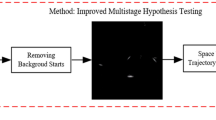Abstract
Identification of known space objects is a critical step in maintaining accurate catalogs for space situational awareness activities. With increasing numbers of objects in orbit, optical measurements of space objects become more populated with detections, stressing the algorithms used to track and identify these objects. Traditional algorithms used for identifying space objects, such as elliptical gating, suffer from ambiguous or incorrect classifications as gates tend to overlap in dense detection environments. An algorithm is developed that couples elliptical gating with a star pattern recognition algorithm called the planar triangle method to overcome the difficulties found in spatially dense observations. Unlike star catalogs, cataloged resident space objects often contain considerable uncertainty, further challenging the identification of objects in a cluttered field-of-view. The proposed approach leverages uncertainties of the catalog as well as the optical measurement sensor uncertainty to support the space object identification. Simulation results using the gating-assisted planar triangle method show a significant improvement in robust identification of space objects as compared to traditional elliptical gating methods when faced with highly cluttered observations.












Similar content being viewed by others
References
Blackman, S., Popoli, R.: Design and Analysis of Modern Tracking Systems. Artech House, Boston (1999)
Cheng, Y., Crassidis, J.L., Markley, F.L.: Attitude estimation for large field-of-view sensors. J. Astronaut. Sci. 54(3&4), 433–448 (2006)
Cole, C.L.: Fast Star Pattern Recognition Using Spherical Triangles. Master’s Thesis, University at Buffalo, State University of New York (2004)
Cole, C.L., Crassidis, J.L.: Fast star-pattern recognition using planar triangles. J. Guid. Control Dyn. 29(1), 64–71 (2006). https://doi.org/10.2514/1.13314
Hinks, J.C., Crassidis, J.L.: Covariance analysis of maximum likelihood attitude estimation. J. Astronaut. Sci. 60(2), 186–210 (2013). https://doi.org/10.1007/s40295-014-0028-7
Johnson, N.L., Stansbery, E., Liou, J.C., Horstman, M., Stokely, C., Whitlock, D.: The characteristics and consequences of the break-up of the Fengyun-1c spacecraft. Acta Astronaut. 63(1), 128–135 (2008). https://doi.org/10.1016/j.actaastro.2007.12.044
Light, D.L.: Satellite Photogrammetry. In: Slama, C C (ed.) Manual of Photogrammetry. 4th edn., p 17. American Society of Photogrammetry, Falls Church (1980)
Mortari, D.: A Fast On-Board Autonomous Attitude Determination System Based on a New Star-Id Technique for a Wide FOV Star Tracker. In: AAS/AIAA Space Flight Mechanics Meeting, pp. 96–158. aAS, Austin (1996)
Shuster, M.D.: Kalman filtering of spacecraft attitude and the QUEST model. J. Astronaut. Sci. 38(3), 377–393 (1990)
Shuster, M.D., Oh, S.D.: Three-axis attitude determination from vector observations. J. Guid. Control 4(1), 70–77 (1981). https://doi.org/10.2514/3.19717
Silversmith, P.E.: Space-Object Identification Using Spatial Pattern Recognition. Master’s Thesis, University at Buffalo, State University of New York (2013)
Spratling, B.B., Mortari, D.: A survey on star identification algorithms. Algorithms 2(1), 93–107 (2009). https://doi.org/10.3390/a2010093
Vallado, D.A.: Fundamentals of Astrodynamics and Applications, 4th edn. Microcosm Press, Torrance (2013)
Acknowledgments
The authors would like to thank the late Samuel S. Blackman for his many helpful discussions.
Author information
Authors and Affiliations
Corresponding author
Additional information
Publisher’s Note
Springer Nature remains neutral with regard to jurisdictional claims in published maps and institutional affiliations.
Rights and permissions
About this article
Cite this article
Kalur, A., Szklany, S.A. & Crassidis, J.L. Space Object Data Association Using Spatial Pattern Recognition Approaches. J Astronaut Sci 67, 1708–1734 (2020). https://doi.org/10.1007/s40295-020-00217-0
Published:
Issue Date:
DOI: https://doi.org/10.1007/s40295-020-00217-0




